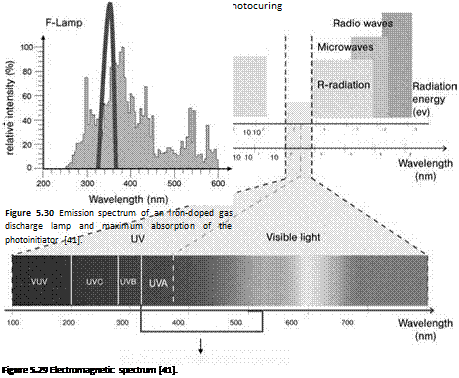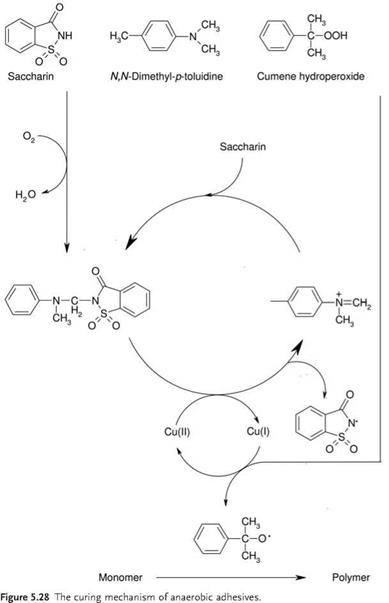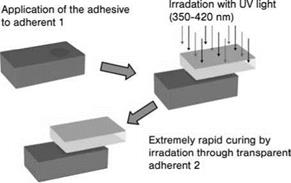UV-setting acrylate adhesives are also radically initiated systems. In contrast to other adhesive systems, they have an extremely high curing rate that is generally on the order of a second or a millisecond [40,41]. UV-setting acrylate adhesives are therefore extremely well suited for bonding purposes in the production ofhigh-precision, high — quality goods manufactured in high quantities. In particular, highly automated processing fits in well with the manufacturing requirements of the electronics industry, where development continues to be extremely rapid.
Curing Through Irradiation The electromagnetic spectrum (Figure 5.29) comprises different regions of radiation which may be either low or high in energy. Radiation with a very long wavelength (e. g. radio waves, microwave radiation) is very low in energy, while radiation with a short wavelength (e. g. X-rays, cosmic radiation) is very high in energy. The lower the energy of the radiation, the less its impact on matter.
Microwaves and infrared (IR) radiation have an accelerating effect on chemical reactions as they induce a rotation or vibration of the molecules. Radiation-based technologies may therefore be used to accelerate or initiate the curing reactions of standard epoxy resin adhesives, for example. To the left of the IR radiation band there is the region of UV radiation which is higher in energy and induces an excitation of the electrons. Initiators which absorb specific wavelengths in the UV/visible band are placed in a state that is high in energy, and this allows them very rapidly to initiate chemical reactions. This technology is used for UV-setting adhesives and will be discussed in detail in the following section.
Absorption and Reaction In order to obtain an effective curing of UV-setting adhesives, the wavelength of the radiation emitted by the UV light source must correspond to the absorption wavelength of the initiator.
|
|
In the example shown in Figure 5.30, only a small portion of the large spectrum of the radiation emitted by a light source is overlapped by the absorption wavelength of the photoinitiator. The light source and adhesive must match as perfectly as possible to obtain the best possible curing effect.
Another factor to be considered is the adherent material. For example, metal substrates reflect radiation, thereby accelerating the reaction and influencing the
 |
degree of crosslinking near the adherent surface. Adherents that are transparent in the visible range (i. e. they can be seen through) are not necessarily translucent with regards to UV radiation. For example, polycarbonate and PMMA (Plexiglas®) contain UV stabilizers that slow down, or even block, the UV curing process.
|
|
In Figure 5.31, a 5 mm-thick PMMA screen is seen to absorb 60% of UVA radiation, 10% of visible light and 100% of UVB/UVC radiation.
Reaction Mechanism With radical curing acrylates, at least one adherent must be translucent for UVA/UVB radiation because these adhesives only cure upon irradiation with light of the necessary wavelength. The reaction stops immediately when the light is removed (Figure 5.32).
An adequate period ofirradiation must be determined in order to obtain full cure. Radical curing systems have several advantages, in that they have not only a very rapid curing rate but also a wide range of almost infinitely variable properties such as viscosity, color, flexibility, hardness and strength, all of which allow customization of the adhesive system.
UV-setting adhesives develop their properties fully provided that a suitable light source is available (Figure 5.33). Today, important advances have been made in light technology, and improved systems with different dimensional characteristics are now available to the user. The wavelengths to be used can also be confined to a specificrange. In generally, the UV radiation is generated by gas discharge lamps, concentrated by
|
Figure 5.32 Schematic of the radical curing of UV acrylates. |
|
Figure 5.33 Balance of performance of a gas discharge lamp [41]. |
|
Table 5.7 Characteristic parameters of UV curing.
|
special reflectors and then transformed into a homogeneous and focused radiation. The radiation emitted by gas discharge lamps, however, has a high percentage of IR rays that may cause damage or deformations in some adherents, especially in plastic materials. By reducing the IR portion while maintaining the UV intensity, special reflectors make it possible to reduce the adherent temperature by up to 50%.
The UV intensity and dose are important curing parameters (Table 5.7). Typically, the UV dose defines the energy density needed to cure an adhesive system, whereas the UV intensity data provide more detailed information, taking different spectral ranges and radiation periods into consideration.
Examples of Application UV-setting adhesives can be used in a wide range of applications, as short curing periods provide for high production rates and short cycle times. Owing to the radical curing mechanism, UV curing can easily be combined with heat curing by adding peroxides, or with anaerobic curing, making it possible to use UV-setting adhesives for bonding sites with shadow regions that are inaccessible to the radiation source. UV-setting adhesives are particularly well suited to the industry sectors, as summarized in Table 5.8.
When UV-setting adhesives are used in industry (Table 5.8) they must meet various different criteria (Table 5.9), for example a rapid curing rate. It has become clear that modern UV-setting adhesives will, in time, take over many very demanding functions that will lead to the creation of new fields of application.
|
Table 5.8 Fields of application of UV-setting adhesives.
|
• Ionic purity
• Solder resistance
• Low coefficient of thermal expansion
• Flow control
• Dosability
• Defined dynamic mechanical properties
Optics • Defined refractive index
• Defined transmission
• Low degree of shrinkage
• High thermal stability
Glass • High transparency
• UV resistance
• Structural bonding requires high strength and durability on glass and combinations of glass with other materials
• Compensation of stress differences
Audio • Good adherence to unusual surfaces such as impregnated paper
• No impairment of acoustic properties
Automobile • Resistance to different media such as oil, gasoline
• Durability over a wide range of in-service temperatures (e. g. -40°C to +150°C)
• Weatherproofness
• Defined dynamic mechanical properties
Design/Fashion • High transparency
• UV resistance
• High abrasion and scratch resistance
Medical devices • Biocompatibility
• High transparency
• Good adherence to plastic materials
• Compatibility with sterilization methods
 23 сентября, 2015
23 сентября, 2015  Pokraskin
Pokraskin 



 Опубликовано в рубрике
Опубликовано в рубрике 